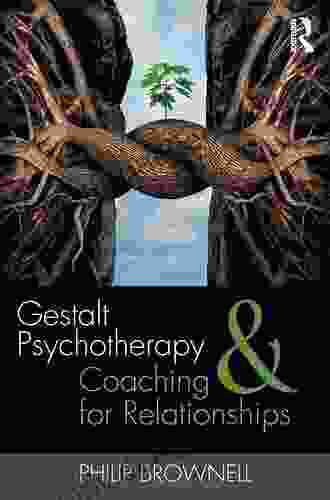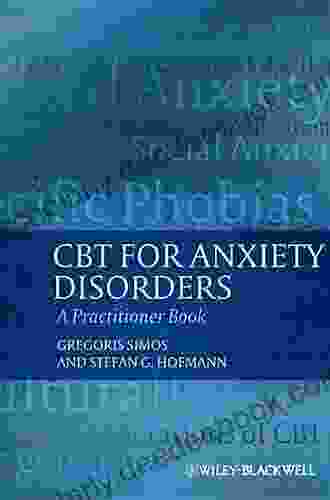Cognitive Behavioral Therapy (CBT) for Anxiety Disorders: A Comprehensive Guide for Practitioners

4.5 out of 5
| Language | : | English |
| File size | : | 1272 KB |
| Text-to-Speech | : | Enabled |
| Screen Reader | : | Supported |
| Enhanced typesetting | : | Enabled |
| Word Wise | : | Enabled |
| Print length | : | 269 pages |
| Lending | : | Enabled |
Anxiety disorders are a prevalent mental health concern, affecting millions of individuals worldwide. Cognitive Behavioral Therapy (CBT) has emerged as an effective and evidence-based treatment approach for various anxiety disorders. This comprehensive article aims to provide practitioners with an in-depth understanding of CBT for anxiety disorders, including its principles, techniques, and strategies. By integrating CBT into their practice, practitioners can empower clients to manage their anxiety effectively and improve their overall well-being.
Understanding Anxiety Disorders
Anxiety disorders encompass a range of conditions characterized by excessive worry, fear, and avoidance of specific situations or objects. Common types of anxiety disorders include:
- Generalized Anxiety Disorder (GAD)
- Panic Disorder
- Social Anxiety Disorder (SAD)
- Phobias (specific fears, e.g., fear of heights, animals, flying)
- Obsessive-Compulsive Disorder (OCD)
- Post-Traumatic Stress Disorder (PTSD)
Principles of CBT for Anxiety Disorders
CBT is rooted in the idea that our thoughts, feelings, and behaviors are interconnected and influence our overall experience. In CBT for anxiety disorders, the focus is on addressing maladaptive thoughts, emotions, and behaviors that contribute to anxiety. Key principles of CBT include:
- Cognitive Restructuring: Identifying and challenging distorted or irrational thoughts that fuel anxiety.
- Behavioral Activation: Engaging in activities and exposures to gradually reduce avoidance and increase positive experiences.
- Mindfulness: Paying attention to the present moment without judgment, promoting awareness and acceptance.
- Relaxation Techniques: Implementing strategies such as deep breathing and muscle relaxation to manage physiological symptoms of anxiety.
- Exposure Therapy: Gradually exposing clients to feared situations or objects in a controlled and safe environment.
CBT Techniques and Strategies
CBT incorporates a range of techniques and strategies tailored to the specific needs of clients with anxiety disorders. Some common CBT techniques include:
- Thought Records: Monitoring and analyzing the connection between thoughts, feelings, and behaviors to identify cognitive distortions.
- Cognitive Restructuring Exercises: Practicing challenging and modifying distorted thoughts, replacing them with more rational and helpful ones.
- Behavioral Experiments: Testing out the validity of anxious thoughts by engaging in real-life situations that challenge assumptions.
- Gradual Exposure: Gradually increasing exposure to feared stimuli while practicing coping skills to reduce avoidance and build tolerance.
- Mindfulness-Based Techniques: Incorporating mindfulness exercises, such as body scans or breathing practices, to enhance awareness and reduce anxiety.
- Relaxation Training: Teaching clients relaxation techniques, such as deep breathing, progressive muscle relaxation, or visualization, to manage physical symptoms of anxiety.
Implementing CBT in Practice
To effectively implement CBT for anxiety disorders, practitioners should adhere to the following steps:
- Establish a Strong Therapeutic Alliance: Building a collaborative and supportive relationship with clients is essential for successful CBT outcomes.
- Conduct a Comprehensive Assessment: Gathering a thorough understanding of the client's anxiety disorder, including its history, symptoms, and impact on functioning.
- Develop a Treatment Plan: Collaboratively establishing clear goals, objectives, and a structured plan for CBT interventions tailored to the client's needs.
- Implement CBT Techniques: Skillfully utilizing CBT techniques and strategies as outlined above, adapting them to the client's individual circumstances.
- Monitor Progress and Adjust Treatment: Regularly assessing the client's progress, providing feedback, and making necessary adjustments to the treatment plan as needed.
- Facilitate Relapse Prevention: Preparing clients for potential setbacks and developing coping strategies to maintain progress after treatment.
Evidence-Base and Effectiveness of CBT
CBT has been extensively studied and proven effective in treating various anxiety disorders. Numerous clinical trials and meta-analyses have demonstrated its efficacy in reducing anxiety symptoms, improving mental health outcomes, and enhancing overall functioning. CBT has been shown to be particularly effective in treating:
- Generalized Anxiety Disorder (GAD)
- Panic Disorder
- Social Anxiety Disorder (SAD)
- Phobias (specific fears, e.g., fear of heights, animals, flying)
Cognitive Behavioral Therapy (CBT) is an evidence-based and effective treatment approach for a wide range of anxiety disorders. By understanding the principles, techniques, and strategies of CBT, practitioners can effectively help clients manage their anxiety, reduce symptoms, and improve their well-being. Implementing CBT in practice requires a collaborative therapeutic alliance, a comprehensive assessment, and a structured treatment plan. With its focus on cognitive restructuring, behavioral activation, mindfulness, and exposure, CBT empowers clients to develop coping skills, challenge negative thought patterns, and engage in positive and fulfilling experiences. By integrating CBT into their practice, practitioners can make a significant impact on the lives of individuals struggling with anxiety disorders.
If you or someone you know is struggling with anxiety, seeking professional help from a qualified mental health practitioner is crucial. CBT can be a transformative treatment approach in addressing anxiety disorders and promoting a more balanced and fulfilling life.
Resources
- American Psychological Association: Cognitive Behavioral Therapy for PTSD
- The National Institute of Health: Cognitive Behavioral Therapy for Anxiety Disorders: A Meta-Analysis
- The National Institute of Health: The Efficacy of CBT for Anxiety Disorders: A Review of Meta-Analyses
- Science Direct: Cognitive Behavioral Therapy for Anxiety Disorders: A Meta-Analysis
- Cambridge University Press: Cognitive Behavioral Therapy for Anxiety Disorders
4.5 out of 5
| Language | : | English |
| File size | : | 1272 KB |
| Text-to-Speech | : | Enabled |
| Screen Reader | : | Supported |
| Enhanced typesetting | : | Enabled |
| Word Wise | : | Enabled |
| Print length | : | 269 pages |
| Lending | : | Enabled |
Do you want to contribute by writing guest posts on this blog?
Please contact us and send us a resume of previous articles that you have written.
 Book
Book Novel
Novel Page
Page Chapter
Chapter Text
Text Library
Library E-book
E-book Magazine
Magazine Newspaper
Newspaper Paragraph
Paragraph Bookmark
Bookmark Shelf
Shelf Bibliography
Bibliography Foreword
Foreword Annotation
Annotation Footnote
Footnote Scroll
Scroll Bestseller
Bestseller Autobiography
Autobiography Reference
Reference Encyclopedia
Encyclopedia Thesaurus
Thesaurus Resolution
Resolution Librarian
Librarian Catalog
Catalog Card Catalog
Card Catalog Stacks
Stacks Archives
Archives Periodicals
Periodicals Study
Study Scholarly
Scholarly Lending
Lending Reserve
Reserve Journals
Journals Literacy
Literacy Study Group
Study Group Thesis
Thesis Dissertation
Dissertation Storytelling
Storytelling Textbooks
Textbooks National Aeronautics And Space Administration
National Aeronautics And Space Administration Nick Worrall
Nick Worrall Dominique Loreau
Dominique Loreau Louisa May Alcott
Louisa May Alcott Chan
Chan Mark Hussey
Mark Hussey Brian J Karem
Brian J Karem Peggy Jones
Peggy Jones Alexander Etkind
Alexander Etkind John Mceuen
John Mceuen Andy Mcwain
Andy Mcwain Juliane Vogel
Juliane Vogel Gilda Morina Syverson
Gilda Morina Syverson Andy Bennett
Andy Bennett Pei Show Juo
Pei Show Juo Hilma Wolitzer
Hilma Wolitzer Laurel A Rockefeller
Laurel A Rockefeller Tony J Hughes
Tony J Hughes Carmen Gil
Carmen Gil Michael Ferrari
Michael Ferrari
Light bulbAdvertise smarter! Our strategic ad space ensures maximum exposure. Reserve your spot today!

 Carlos FuentesNaughtier Than Nice McBroom Sisters: A Captivating Look into Family Dynamics...
Carlos FuentesNaughtier Than Nice McBroom Sisters: A Captivating Look into Family Dynamics... Henry David ThoreauFollow ·6.8k
Henry David ThoreauFollow ·6.8k Israel BellFollow ·14.3k
Israel BellFollow ·14.3k Eliot FosterFollow ·4k
Eliot FosterFollow ·4k Jeremy CookFollow ·9.2k
Jeremy CookFollow ·9.2k Marvin HayesFollow ·15.2k
Marvin HayesFollow ·15.2k Craig CarterFollow ·16.3k
Craig CarterFollow ·16.3k Glen PowellFollow ·17.3k
Glen PowellFollow ·17.3k Douglas AdamsFollow ·10.7k
Douglas AdamsFollow ·10.7k

 Houston Powell
Houston PowellMusorgsky and His Circle: A Russian Musical Revolution
Modest Mussorgsky was a Russian...
 Barry Bryant
Barry BryantRanking the 80s with Bill Carroll: A Nostalgic Journey...
Prepare to embark on a captivating...

 Kelly Blair
Kelly BlairThe Diplomat's Travel Guide to Festivals, Holidays, and...
India is a land of vibrant culture and...

 José Saramago
José SaramagoFancy Nancy Nancy Clancy: Late-Breaking News!
Nancy Clancy is back with all-new adventures...

 Trevor Bell
Trevor BellGestalt Psychotherapy and Coaching for Relationships: A...
Relationships...

 Federico García Lorca
Federico García LorcaThe Last Love of George Sand: An Enduring Legacy of...
At the twilight of her remarkable life,...
4.5 out of 5
| Language | : | English |
| File size | : | 1272 KB |
| Text-to-Speech | : | Enabled |
| Screen Reader | : | Supported |
| Enhanced typesetting | : | Enabled |
| Word Wise | : | Enabled |
| Print length | : | 269 pages |
| Lending | : | Enabled |










